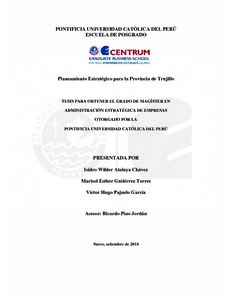| dc.contributor.advisor | Pino Jordan, Ricardo Miguel | |
| dc.contributor.author | Atalaya Chávez, Isidro Wilder | es_ES |
| dc.contributor.author | Gutiérrez Torres, Marisol Esther | es_ES |
| dc.contributor.author | Pajuelo García, Víctor Hugo | es_ES |
| dc.date.accessioned | 2018-09-23T19:57:47Z | |
| dc.date.available | 2018-09-23T19:57:47Z | |
| dc.date.created | 2018 | |
| dc.date.issued | 2018-09-23 | |
| dc.identifier.uri | http://hdl.handle.net/20.500.12404/12712 | |
| dc.description.abstract | El siguiente plan estratégico está pensado para la provincia de Trujillo, ubicada en la región
La Libertad, al noroeste del Perú. Como fortalezas, esta provincia tiene asociaciones
agrícolas, que permiten incrementar la oferta exportable, destacando en la producción y
exportación de espárragos, que se combinan con otros cultivos como la palta y la alcachofa.
Además, hay una amplia oferta de atractivos turísticos, que incluye sitios arqueológicos,
lugares naturales, religiosos y culturales; y se tiene una industria manufacturera en
crecimiento, donde los principales productos son la harina de pescado, los tableros
aglomerados de madera y el calzado de cuero. Sin embargo, su infraestructura vial adolece de
una gestión municipal ineficiente. Para incrementar las fortalezas de la provincia y
aprovechar sus oportunidades, se han creado y revisado minuciosamente diversas estrategias,
que al ser implementadas permitirán lograr la visión que se tiene al 2028. Esta visión aspira a
ser la primera provincia a nivel nacional en producción de calzado y exportación de
espárragos, desarrollando también el turismo con el fin de eliminar la pobreza extrema. Se
recomienda poner en funcionamiento las siguientes estrategias: (a) implementar el desarrollo
de paquetes turísticos por segmentos (vivenciales, exclusivos, de aventura), (b) desarrollar el
mercado ruso de vegetales frescos y procesados, (c) desarrollar nuevos productos
agroindustriales de exportación, para penetrar en los mercados de Estados Unidos de
Norteamérica y Europa; y (d) implementar la promoción de zonas clave para el desarrollo
económico de la ciudad, como son Centro Histórico, Corredor Gastronómico, Zona
Comercial y Zona Industrial, con inversión pública y privada, entre otras. Para lograr esto, y
buscando generar ventaja competitiva, se conformarán tres clústeres, uno para la industria
turística, uno para la manufactura de calzado de cuero y otro para la agroindustria,
involucrando a proveedores, productores, procesadores, empacadores y transportistas. | es_ES |
| dc.description.abstract | The following strategic plan is designed for the province of Trujillo, located in La Libertad
region, northwest of Peru. As strengths, this province has agricultural associations, which
allow increasing the exportable supply, highlighting the production of and export of
asparagus, which is combined with other crops such as avocado and artichoke. In addition,
there is a wide range of tourist attractions, including archaeological sites, natural, religious
and cultural places; as well there is also the production of fish flour, wood pieces and leather
footwear. However, there is a road infrastructure, with inefficient municipal management. In
order to increase the strengths that the province has and take advantage of the opportunities,
diverse strategies have been created and reviewed in detail, which, when implemented, will
achieve the vision of 2028. The same that establishes being the first province in the country
in leather footwear production as well as in asparagus exports, developing the tourism
industry, to eliminate extreme poverty. The recommended strategies to implement are: (a)
implementing the development of tour packages by segments (experiential, exclusive,
adventure), (b) developing the Russian market of fresh and processed vegetables, (c)
Developing new agro-industrial export products , to penetrate the markets of the United
States of America and Europe; and (d) implement the promotion of key zones for the
economic development of the city such as the Historic Center, Gastronomic Corridor,
Commercial Zone and Industrial Zone, with public and private investment; among others. To
achieve this, and seeking to generate competitive advantage, three clusters will be formed,
one for the tourism industry, a second one for leather footwear sector and the other for agroindustry,
involving suppliers, producers, processors, packers and transporters. | es_ES |
| dc.language.iso | spa | es_ES |
| dc.publisher | Pontificia Universidad Católica del Perú | es_ES |
| dc.rights | info:eu-repo/semantics/openAccess | es_ES |
| dc.rights.uri | http://creativecommons.org/licenses/by-nc-nd/2.5/pe/ | * |
| dc.subject | Planificación regional--Perú--La Libertad--Trujillo | es_ES |
| dc.subject | Desarrollo regional--Perú--La Libertad--Trujillo | es_ES |
| dc.subject | Planificación estratégica | es_ES |
| dc.title | Planeamiento estratégico para la provincia de Trujillo | es_ES |
| dc.type | info:eu-repo/semantics/masterThesis | es_ES |
| thesis.degree.name | Maestro en Administración Estratégica de Empresas | es_ES |
| thesis.degree.level | Maestría | es_ES |
| thesis.degree.grantor | Pontificia Universidad Católica del Perú. CENTRUM | es_ES |
| thesis.degree.discipline | Administración Estratégica de Empresas | es_ES |
| renati.discipline | 413307 | es_ES |
| renati.level | https://purl.org/pe-repo/renati/level#maestro | es_ES |
| renati.type | https://purl.org/pe-repo/renati/type#tesis | es_ES |
| dc.publisher.country | PE | es_ES |
| dc.subject.ocde | https://purl.org/pe-repo/ocde/ford#5.02.04 | es_ES |






